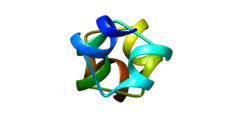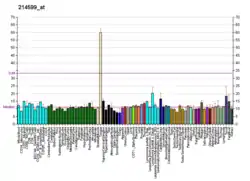| IVL | |||||||||||||||||||||||||||||||||||||||||||||||||||
|---|---|---|---|---|---|---|---|---|---|---|---|---|---|---|---|---|---|---|---|---|---|---|---|---|---|---|---|---|---|---|---|---|---|---|---|---|---|---|---|---|---|---|---|---|---|---|---|---|---|---|---|
 | |||||||||||||||||||||||||||||||||||||||||||||||||||
| |||||||||||||||||||||||||||||||||||||||||||||||||||
| Identifiers | |||||||||||||||||||||||||||||||||||||||||||||||||||
| Aliases | IVL, involucrin | ||||||||||||||||||||||||||||||||||||||||||||||||||
| External IDs | OMIM: 147360 HomoloGene: 136793 GeneCards: IVL | ||||||||||||||||||||||||||||||||||||||||||||||||||
| |||||||||||||||||||||||||||||||||||||||||||||||||||
| |||||||||||||||||||||||||||||||||||||||||||||||||||
| |||||||||||||||||||||||||||||||||||||||||||||||||||
| |||||||||||||||||||||||||||||||||||||||||||||||||||
| Wikidata | |||||||||||||||||||||||||||||||||||||||||||||||||||
| |||||||||||||||||||||||||||||||||||||||||||||||||||
| Involucrin of squamous epithelia N-terminus | |||||||||
|---|---|---|---|---|---|---|---|---|---|
| Identifiers | |||||||||
| Symbol | Involucrin_N | ||||||||
| Pfam | PF10583 | ||||||||
| InterPro | IPR019571 | ||||||||
| |||||||||
| Involucrin repeat | |||||||||
|---|---|---|---|---|---|---|---|---|---|
| Identifiers | |||||||||
| Symbol | Involucrin | ||||||||
| Pfam | PF00904 | ||||||||
| InterPro | IPR000354 | ||||||||
| SCOP2 | 1eu0 / SCOPe / SUPFAM | ||||||||
| |||||||||
| Involucrin repeat | |||||||||
|---|---|---|---|---|---|---|---|---|---|
| Identifiers | |||||||||
| Symbol | Involucrin2 | ||||||||
| Pfam | PF06994 | ||||||||
| InterPro | IPR009733 | ||||||||
| |||||||||
Involucrin is a protein component of human skin and in humans is encoded by the IVL gene.[3][4] In binding the protein loricrin, involucrin contributes to the formation of a cell envelope that protects corneocytes in the skin.
Gene
This gene is mapped to 1q21, among calpactin I light chain, trichohyalin, profillaggrin, loricrin, and calcyclin.[4]
Function
Involucrin is a highly reactive, soluble, transglutaminase substrate protein present in keratinocytes of epidermis and other stratified squamous epithelia.[5][6] It first appears in the cell cytosol, but ultimately becomes cross-linked to membrane proteins by transglutaminase thus helping in the formation of an insoluble envelope beneath the plasma membrane functioning as a glutamyl donor during assembly of the cornified envelope.[7]
Involucrin is synthesised in the stratum spinosum and cross linked in the stratum granulosum by the transglutaminase enzyme that makes it highly stable. Thus it provides structural support to the cell, thereby allowing the cell to resist invasion by micro-organisms.
Apigenin, a plant-derived flavanoid that has significant promise as a skin cancer chemopreventive agent, has been found to regulate normal human keratinocyte differentiation by suppressing involucrin, and this is associated with reduced cell proliferation without apoptosis.[8]
Clinical significance
As one of the precursor proteins of the cornified cell envelope, involucrin is markedly increased in inflammatory skin diseases such as psoriasis[9]
Lamellar ichthyosis involves a decrease in expression of involucrin. This decrease could contribute to the altered desquamation process seen in the disease, since the clinical improvement associated with retinoid treatment is accompanied by increased expression of involucrin.[10]
Structure
Involucrin consists of a conserved N-terminal region of about 75 amino acid residues followed by two extremely variable length segments that contain glutamine-rich tandem repeats. The glutamine residues in the tandem repeats are the substrate for the transglutaminase in the cross-linking reaction. The total size of the protein varies from 285 residues (in dog) to 835 residues (in orangutan).
References
- 1 2 3 GRCh38: Ensembl release 89: ENSG00000163207 - Ensembl, May 2017
- ↑ "Human PubMed Reference:". National Center for Biotechnology Information, U.S. National Library of Medicine.
- ↑ Eckert RL, Green H (August 1986). "Structure and evolution of the human involucrin gene". Cell. 46 (4): 583–9. doi:10.1016/0092-8674(86)90884-6. PMID 2873896. S2CID 39293076.
- 1 2 "Entrez Gene: IVL involucrin".
- ↑ Green H, Djian P (November 1992). "Consecutive actions of different gene-altering mechanisms in the evolution of involucrin". Molecular Biology and Evolution. 9 (6): 977–1017. doi:10.1093/oxfordjournals.molbev.a040775. PMID 1359382.
- ↑ Djian P, Phillips M, Easley K, Huang E, Simon M, Rice RH, Green H (November 1993). "The involucrin genes of the mouse and the rat: study of their shared repeats". Molecular Biology and Evolution. 10 (6): 1136–49. doi:10.1093/oxfordjournals.molbev.a040069. PMID 8277848.
- ↑ Eckert RL, Yaffe MB, Crish JF, Murthy S, Rorke EA, Welter JF (May 1993). "Involucrin--structure and role in envelope assembly". The Journal of Investigative Dermatology. 100 (5): 613–7. doi:10.1111/1523-1747.ep12472288. PMID 8098344.
- ↑ Balasubramanian S, Zhu L, Eckert RL (November 2006). "Apigenin inhibition of involucrin gene expression is associated with a specific reduction in phosphorylation of protein kinase Cdelta Tyr311". The Journal of Biological Chemistry. 281 (47): 36162–72. doi:10.1074/jbc.M605368200. PMID 16982614.
- ↑ Takahashi H, Hashimoto Y, Ishida-Yamamoto A, Iizuka H (September 2005). "Roxithromycin suppresses involucrin expression by modulation of activator protein-1 and nuclear factor-kappaB activities of keratinocytes". Journal of Dermatological Science. 39 (3): 175–82. doi:10.1016/j.jdermsci.2005.03.006. PMID 16140218.
- ↑ Peña-Penabad C, de Unamuno P, García Silva J, Ludeña MD, González Sarmiento R, Pérez-Arellano JL (1999). "Altered expression of immunoreactive involucrin in lamellar ichthyosis". European Journal of Dermatology. 9 (3): 197–201. PMID 10210784.
Further reading
- Eckert RL, Crish JF, Efimova T, Dashti SR, Deucher A, Bone F, Adhikary G, Huang G, Gopalakrishnan R, Balasubramanian S (July 2004). "Regulation of involucrin gene expression". The Journal of Investigative Dermatology. 123 (1): 13–22. doi:10.1111/j.0022-202X.2004.22723.x. PMID 15191537.
- Rice RH, Green H (November 1979). "Presence in human epidermal cells of a soluble protein precursor of the cross-linked envelope: activation of the cross-linking by calcium ions". Cell. 18 (3): 681–94. doi:10.1016/0092-8674(79)90123-5. PMID 42494. S2CID 23066704.
- Yaffe MB, Beegen H, Eckert RL (June 1992). "Biophysical characterization of involucrin reveals a molecule ideally suited to function as an intermolecular cross-bridge of the keratinocyte cornified envelope". The Journal of Biological Chemistry. 267 (17): 12233–8. doi:10.1016/S0021-9258(19)49829-3. PMID 1601889.
- Simon M, Green H (December 1988). "The glutamine residues reactive in transglutaminase-catalyzed cross-linking of involucrin". The Journal of Biological Chemistry. 263 (34): 18093–8. doi:10.1016/S0021-9258(19)81327-3. PMID 2461365.
- Heller M, Flemington E, Kieff E, Deininger P (March 1985). "Repeat arrays in cellular DNA related to the Epstein-Barr virus IR3 repeat". Molecular and Cellular Biology. 5 (3): 457–65. doi:10.1128/mcb.5.3.457. PMC 366737. PMID 2985954.
- Welter JF, Crish JF, Agarwal C, Eckert RL (May 1995). "Fos-related antigen (Fra-1), junB, and junD activate human involucrin promoter transcription by binding to proximal and distal AP1 sites to mediate phorbol ester effects on promoter activity". The Journal of Biological Chemistry. 270 (21): 12614–22. doi:10.1074/jbc.270.21.12614. PMID 7759510.
- Volz A, Korge BP, Compton JG, Ziegler A, Steinert PM, Mischke D (October 1993). "Physical mapping of a functional cluster of epidermal differentiation genes on chromosome 1q21". Genomics. 18 (1): 92–9. doi:10.1006/geno.1993.1430. PMID 8276421.
- Takahashi H, Iizuka H (January 1993). "Analysis of the 5'-upstream promoter region of human involucrin gene: activation by 12-O-tetradecanoylphorbol-13-acetate". The Journal of Investigative Dermatology. 100 (1): 10–5. doi:10.1111/1523-1747.ep12349867. PMID 8380829.
- Lopez-Bayghen E, Vega A, Cadena A, Granados SE, Jave LF, Gariglio P, Alvarez-Salas LM (January 1996). "Transcriptional analysis of the 5'-noncoding region of the human involucrin gene". The Journal of Biological Chemistry. 271 (1): 512–20. doi:10.1074/jbc.271.1.512. PMID 8550612.
- Takahashi H, Kobayashi H, Matsuo S, Iizuka H (1995). "Repression of involucrin gene expression by transcriptional enhancer factor 1 (TEF-1)". Archives of Dermatological Research. 287 (8): 740–6. doi:10.1007/BF01105799. PMID 8554386. S2CID 23203303.
- Steinert PM, Marekov LN (January 1997). "Direct evidence that involucrin is a major early isopeptide cross-linked component of the keratinocyte cornified cell envelope". The Journal of Biological Chemistry. 272 (3): 2021–30. doi:10.1074/jbc.272.3.2021. PMID 8999895.
- Robinson NA, Lapic S, Welter JF, Eckert RL (May 1997). "S100A11, S100A10, annexin I, desmosomal proteins, small proline-rich proteins, plasminogen activator inhibitor-2, and involucrin are components of the cornified envelope of cultured human epidermal keratinocytes". The Journal of Biological Chemistry. 272 (18): 12035–46. doi:10.1074/jbc.272.18.12035. PMID 9115270.
- Ng DC, Su MJ, Kim R, Bikle DD (January 1996). "Regulation of involucrin gene expression by calcium in normal human keratinocytes". Frontiers in Bioscience. 1: a16-24. doi:10.2741/A101. PMID 9159190.
- Banks EB, Crish JF, Welter JF, Eckert RL (April 1998). "Characterization of human involucrin promoter distal regulatory region transcriptional activator elements-a role for Sp1 and AP1 binding sites". The Biochemical Journal. 331 (1): 61–8. doi:10.1042/bj3310061. PMC 1219321. PMID 9512462.
- Marekov LN, Steinert PM (July 1998). "Ceramides are bound to structural proteins of the human foreskin epidermal cornified cell envelope". The Journal of Biological Chemistry. 273 (28): 17763–70. doi:10.1074/jbc.273.28.17763. PMID 9651377.
- Crish JF, Zaim TM, Eckert RL (November 1998). "The distal regulatory region of the human involucrin promoter is required for expression in epidermis". The Journal of Biological Chemistry. 273 (46): 30460–5. doi:10.1074/jbc.273.46.30460. PMID 9804813.
- Lee CH, Marekov LN, Kim S, Brahim JS, Park MH, Steinert PM (July 2000). "Small proline-rich protein 1 is the major component of the cell envelope of normal human oral keratinocytes". FEBS Letters. 477 (3): 268–72. doi:10.1016/S0014-5793(00)01806-8. PMID 10908733. S2CID 12228606.
- Candi E, Oddi S, Terrinoni A, Paradisi A, Ranalli M, Finazzi-Agró A, Melino G (September 2001). "Transglutaminase 5 cross-links loricrin, involucrin, and small proline-rich proteins in vitro". The Journal of Biological Chemistry. 276 (37): 35014–23. doi:10.1074/jbc.M010157200. PMID 11443109.
- Crish JF, Bone F, Banks EB, Eckert RL (January 2002). "The human involucrin gene contains spatially distinct regulatory elements that regulate expression during early versus late epidermal differentiation". Oncogene. 21 (5): 738–47. doi:10.1038/sj.onc.1205038. PMID 11850802.


